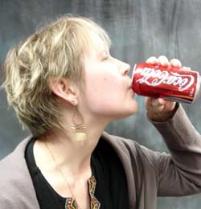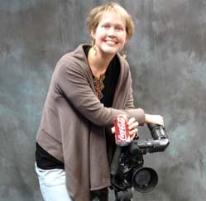CQU researcher says films are at the mercy of big business
Published on 24 August, 2005
Product placement in films has become a major money spinner for film producers in recent years and not only is it unlikely to change but may become more prominent, according to a Central Queensland University researcher.
CQU PhD candidate Tanya Nitins (pictured) said the film industry of today is in fact a multi-faceted network of commercial synergy and corporate integration with product placement an important component.
 “The film industry’s reliance on such business arrangements has somewhat empowered companies to demand that their products be given a more prominent position in a film. In fact, some commodities have even managed to thrust themselves, quite literally, into the spotlight.”.
“The film industry’s reliance on such business arrangements has somewhat empowered companies to demand that their products be given a more prominent position in a film. In fact, some commodities have even managed to thrust themselves, quite literally, into the spotlight.”.
Ms Nitins said when she first began researching this topic she regarded all forms of advertising in films, particularly product placement, as being underhanded attempts at targeting unwary audiences with unsolicited commercial messages, however, she soon realized this would be a fruitless argument.
“To regard all forms of product placement as being inherently negative, with the belief that the practice must be eliminated in order to preserve the integrity of a film is, a little like holding out a hand to stop the onslaught of a tidal wave.”.
“To eliminate it completely would not only be virtually impossible, it could also prove to be detrimental to the production of smaller, independent features that often rely on advertising revenue and support to even get their projects off the ground.”.
One of the more lucrative arrangements involved a US$20million investment by BMW for the launch of its new car – the Z3 Roadster – as featured in the film 'Goldeneye' (Martin Campbell, 1995).
Even as far back as the 1930s and 1940s, script alterations at the behest of advertisers were occurring. At this time the diamond broker De Beers initiated a public relations campaign to increase the profile of diamonds in the Hollywood film industry. Their efforts successfully resulted in a film changing its title from 'Diamonds are Dangerous' to the more innocuous 'Adventures in Diamonds' (George Ditzmaurice, 1940).
 More recently, AOL managed to persuade writer/director Nora Ephron to change the name of her 1998 film starring Meg Ryan and Tom Hanks from 'You Have Mail' to 'You’ve Got Mail', in order to exactly duplicate AOL’s trademark phrase.
More recently, AOL managed to persuade writer/director Nora Ephron to change the name of her 1998 film starring Meg Ryan and Tom Hanks from 'You Have Mail' to 'You’ve Got Mail', in order to exactly duplicate AOL’s trademark phrase.
“The challenge facing the film industry now is to somehow find a way to fulfil the financial and commercial agreements now synonymous with cinema in such a way as to avoid adversely impacting upon the director’s creative ability to construct a film as they see fit.”.
Ms Nitins believes film makers may also need to keep their word to corporate investors to avoid severe ramifications.
“In one of the biggest lawsuits ever seen by the film industry, Reebok sued Tristar Pictures over its negative portrayal in the film 'Jerry Maguire' (Cameron Crowe, 1996). The dispute originated after Crowe chose to exclude a Reebok advertisement from the film’s credits, claiming the commercial “no longer fit creatively in the film”.

